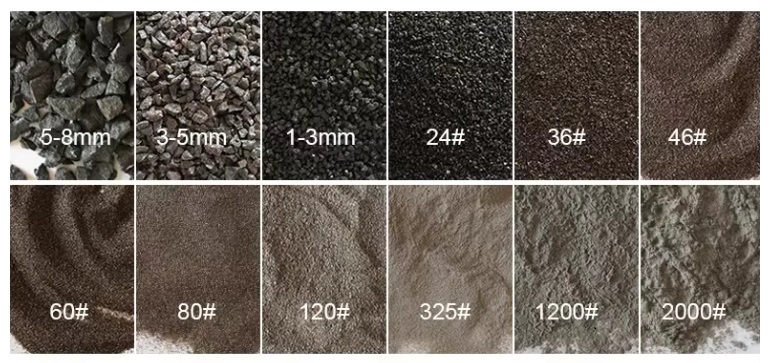Home / News & Blog / Abrasive Blog / The Importance of Abrasive Grain Size and Shape on Abrasive Tool Performance
In industrial manufacturing and material processing, abrasives are crucial tools for efficient and precise machining. Whether it’s grinding wheels, sanding belts, or polishing discs, the performance of these tools directly impacts processing efficiency, surface quality, and tool lifespan. The performance of abrasives largely depends on the size and shape of the abrasive grains used. Today, I want to explore the importance of abrasive grain size and shape on tool performance, based on real-world applications.
Abrasive grain size is one of the core parameters in abrasive tool design. It directly affects cutting ability, surface finish quality, and tool lifespan.

Cutting Ability and Processing Efficiency
Larger abrasive grains have stronger cutting ability and can quickly remove material, making them suitable for roughing or situations where a lot of material needs to be removed. For instance, in deburring metal castings or initial grinding, coarse abrasive tools can significantly improve efficiency.
However, large abrasive grains can also lead to rough surfaces on the workpiece and even cause deep scratches. Therefore, coarse abrasives are typically used in applications where precision is not a major concern.
Surface Finish Quality
Smaller abrasive grains offer finer machining effects, making them suitable for processes such as precision grinding and polishing, where high surface quality is required. For example, when processing optical glass or precision components, fine abrasive grains can achieve nano-level surface roughness to meet high-precision demands.
But fine abrasive tools have lower cutting efficiency, leading to longer processing times. In practical production, multiple stages of abrasive tools are often used, from coarse to fine, to achieve the desired surface finish.
Abrasives Tool Lifespan
Grain size also affects the lifespan of abrasive tools. Larger abrasive grains, due to their strong cutting ability, wear out faster, resulting in a shorter lifespan. On the other hand, smaller grains, with their lower cutting force, wear more slowly, extending the lifespan of the tool. Therefore, when selecting abrasives, a balance must be made between processing needs and cost.
The shape of abrasive grains determines how the abrasive interacts with the workpiece, the distribution of cutting forces, and the overall processing results. It is another key factor affecting tool performance.

Sharp Grains
Sharp grains (such as angular abrasives) have a stronger cutting ability, making them suitable for processing hard or high-strength materials. For example, silicon carbide or diamond abrasives, with their sharp grain shapes, are commonly used for cutting and grinding ceramics, glass, and hard alloys.
However, sharp grains can also cause damage to the workpiece surface, so they should be used carefully in fine finishing processes.
Rounded Grains
Rounded grains (such as spherical abrasives) are better suited for polishing or surface treatment. Their larger contact area with the workpiece allows for more even pressure distribution, resulting in a smoother surface. For instance, in metal polishing, aluminum oxide or zirconium oxide abrasives with rounded grains can effectively reduce surface defects and achieve a mirror finish.
Irregular Grains
Irregularly shaped grains (such as fractured abrasives) have multiple cutting edges, allowing them to work in different directions. These abrasives are ideal for processing complex-shaped workpieces, such as molds or curved surfaces. However, irregular grains may cause uneven surface quality, so they should be used in combination with other abrasives for fine finishing.
In practical production, the selection of abrasive grain size and shape must be optimized according to the specific processing requirements. Here are some common application scenarios:
Roughing
Coarse abrasives with sharp grains, such as rough grinding wheels or sanding belts, are used to quickly remove material and improve processing efficiency.
Finishing
Fine abrasives with rounded grains, such as fine grinding wheels or polishing pads, are used to achieve a high-quality surface finish for precision machining.
Complex Shape Machining
Abrasives with irregular grains, such as flexible grinding wheels or abrasive brushes, are used to adapt to the complex geometry of workpieces, ensuring uniform processing.
High-Hardness Material Machining
Abrasives with sharp grains, such as diamond or cubic boron nitride, are used to process hard materials like hard alloys, ceramics, and other difficult-to-machine materials.
The size and shape of abrasive grains are key factors that influence the performance of abrasive tools. Grain size determines the tool’s cutting ability, surface finish quality, and lifespan, while grain shape affects the tool’s application range and machining results. In practical applications, it is essential to choose the right abrasive grain size and shape based on the material being processed, the required process, and cost considerations, in order to achieve efficient, precise, and cost-effective machining results.
Whether it’s roughing or finishing, the design and selection of abrasives depend on a thorough understanding of the characteristics of abrasive grains. Only by fully grasping these properties can we maximize the performance of abrasive tools, improving both processing efficiency and quality. I hope this discussion provides some insights and guidance for selecting and applying abrasives in your processes!